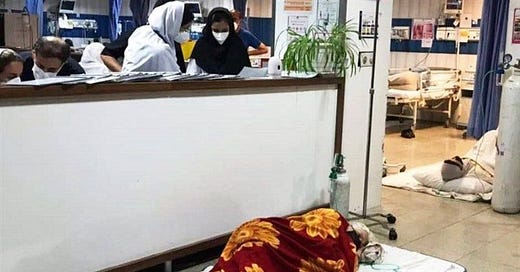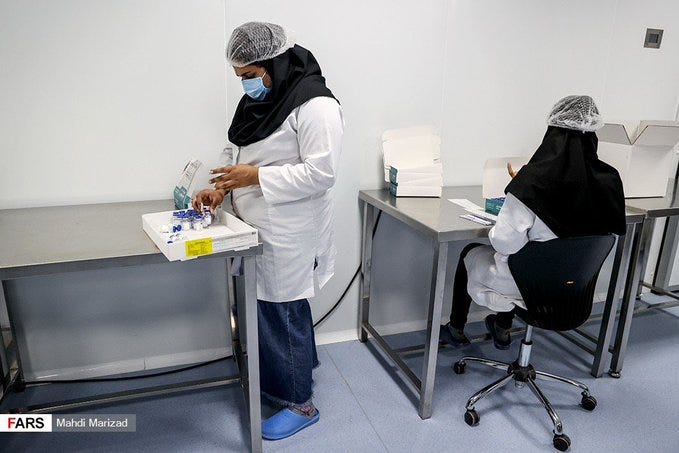Ali Kheyrollahi, London
Covid19 is a never-ending nightmare gripping the nation, wave after wave, killing scores, eating up valuable resources, and wearing out medical staff. Patients lie on the floors of the hospital wards and on seats along the corridors. Hospitals care for patients in their courtyards. Patients receive IV drips on the street. General wards admit patients in critical condition only to watch them perish for want of ICU beds. Families carry their loved ones on stretchers in the streets. The dead pile up: Hospital morgues have no more room. Taxis transfer the dead to cemeteries because there are no more hearses. Even the most basic medications, such as IV fluids, have run out. Massive queues form in front of and inside the pharmacies.
These scenes are not from a dystopian Hollywood movie; they are happening right now in Iran, witnessed by many and documented in countless photos and videos shared on the social media. Iran is experiencing a fifth Covid wave, this time from the notorious Delta variant; it has proven the most deadly, breaking all previous national Covid records. According to the health officials, Iran’s health system has imploded under the burden of caring for Covid patients—this in a country known for a modern medical system that serves thousands of medical tourists every year.
Iran was one of the first countries where the deadly impacts of Coronavirus were vividly observed, allowing officials to experience firsthand the serious consequences of the epidemic (now a pandemic) and devise a plan to combat it. But after a year and half, while most countries—including neighbouring Turkey and Pakistan—have contained the epidemic with mass vaccination and social distancing, the prospects for Iran remain bleak. With current measures, even by the admission of its own health experts, Iran will be experiencing a sixth wave, a seventh, and more. The country so far has managed to fully vaccinate a mere four percent of the population, arguably the most important reason for the recurrence of these disease peaks. But why?
It turns out Iran does not have enough vaccines. Dr. Alireza Zali, head of the Covid19 task force in Tehran, revealed that the country currently only has vaccine reserves for five days. Surely sanctions must be blamed for imposing restrictions on vaccine imports, no?
No. It turns out Iran could have bought vaccines as early as January—the first shipment of Covid vaccines was secured in late December, 2020—but it chose not to. The government has blamed sanctions for its challenges in transferring funds for vaccine purchases, but in fact this is mainly due to Iran’s refusal (along with North Korea) to join FATF, the international initiative designed to combat money laundering. But even with the impediments from FATF and sanctions, Iran's funds were unlocked to pay for vaccines, on humanitarian grounds.
So if Iran could import vaccines, why didn't they?
While everyday we learn more about how these decisions were made, these were the ostensible rationales: First, Iran prefers to develop homegrown technologies so that it can make national vaccines rather than buying them. This is in line with the revolutionary idealism of self-reliance. Second, Iran prefers to buy vaccines from its Eastern allies (China and Russia) than from Western countries such as the US and UK. In fact, Iran’s Supreme Leader banned importing vaccines from the US and UK labelling them "untrustworthy.” Parliament’s Center for Research at the time recommended that a small number of vaccines for medical staff be imported from non-Western countries; as for the general public, we should wait for the effectiveness of the vaccines to be proven, by which time the homegrown vaccines would be available. It also insisted on delegating these projects to private companies with no established history in vaccine production, arguing they had proven more efficient—a controversial argument that looks at best misguided in a country tangled in a web of corruption.
This decision led to Iran's inability to import Pfizer, AstraZeneca, and Moderna. And while a few batches of the Russian Sputnik V vaccine did arrive early on, production and fulfilment challenges ensured some recipients were unable to receive the second dose—simply waste of those first doses.
What about the homegrown vaccine? Iran unveiled seven different Iranian Covid vaccine projects, each receiving grants—a number that has now swelled to a whopping 21. While Iran has been making basic vaccines and serums for many decades, it has never had a history of making modern biological vaccines, and surely nothing at such a large scale—a major and obvious obstacle dismissed by the authorities as a hollow excuse made by West-loving dissidents who couldn’t bear to see their country progress and prosper.
The debate about whether to buy or make vaccines shifted to social media, with the majority asking for the immediate purchase and import of the vaccine, using the “buy vaccines” hashtag (#واکسن_بخرید), while the conservatives and hardliners responded with the hashtag “make vaccines” (#واکسن_بسازید). But the decision was already made—and in hindsight resulted in the unnecessary death of thousands of civilians.
As these projects progressed, there was no shortage of boasting. The Health Minister promised in February that within months, Iran would be a major COVID vaccine producer and exporter. Later, they announced that several countries, including Switzerland, intended to purchase the Barekat vaccine when it entered mass production. As for production, they announced that by early August, 18 million doses of the Barekat vaccine (and by early September, fifty million) would be delivered. They claimed it surpassed international standards of effectiveness.
But it was only a matter of time, precious time, before these claims were debunked. The Barekat vaccine does not yet have the WHO’s approval, and apparently has not yet applied for it. The only scientific publications on the vaccine treat animal safety studies; experts have shown these suffer from a number of systematic and methodological errors. As for the mass production instead of 18 million doses, only slightly more than 1.8 million doses were delivered in the proposed time frame.
According to Mohammad Mokhber, director of the execution of Imam Khomeini's order, 3000 billion tomans (US$714M according to official exchange rates and US$117M according to market exchange rates) has been spent in the process. Apart from a PR video showing the progress of the building, hailing it as the biggest vaccine production center in the region, pictures that surfaced on social media show a manual, ad-hoc, and embarrassing basic production where even the labels are attached by hand.
Worse still, officials are backtracking on their previous bold claims and saying that never mind exports, Iran’s homegrown production isn’t even enough for its domestic needs, and Iran must now urgently import 30-40 million doses.
After a precious eight months, and many thousands of deaths later, we are back where we started. As for Mohammad Mokhber, director of the Execution of Imam Khomeini’s Order and Iran’s vaccine production hero, he has been appointed the new elected president’s vice president.
“A teenager is admitted in the Covid ward of the hospital, silently crying behind the curtain. Half of his lung is involved and with good care his oxygen levels are just below normal. He has been crying almost non-stop, and at times his tears are dry. He lost his father five days ago. We tried to hide the death of his mother, but after a while we gave in and told him—he has lost seven of his relatives in just two weeks. Yesterday, a brother and sister were admitted alongside each other—they both died. Same destiny for a mother and daughter admitted in the ward above. This is a massacre.”
These are the words of Dr. Mostafa Jalali-Fakhr, an internal medicine specialist in Tehran, who himself contracted Covid after publishing this post on his Instagram feed a few days ago.
There are no words that can describe the suffering of the ordinary people who are stuck between a deadly virus and a theocratic establishment that, according to Dr. Zali, did not import vaccines because it felt that would be too expensive, misreported its statistics to the WHO to paint a more positive picture, returned donated vaccines as soon as they arrived at the airport, and refuses to employ Médecins Sans Frontières volunteers when they arrived. It spent US$720 million on importing Remdesivir, which is only slightly better than a placebo—equivalent to the funds needed to import enough doses to vaccinate most of the country. Why? Because there was no Supreme Leader order forbidding it, and quite possibly the corruption networks that operate in this area benefited from it.
While the official number of Covid casualties stands at 100 thousand, a recent excess death study suggests that the true figure is at least twice that. It is very hard now to find someone who has not lost a friend or a relative to the disease. Most Iranians have lost any hope that their lives will improve.
This is a sad story—the story of a nation that deserves a normal life like any other, and a state that finds itself completely helpless when left to its own devices.
Writing these lines is not the kind of help they need, but at least the story of their suffering—the voice of the helpless—is being heard.
Ali Kheyrollahi is an Iran observer and analyst








It amazes me that Iran hasn't adopted a version of the Internet similar to China's. Authoritarian theocrats cannot handle information being so available, even if they were well-intentioned.
Perhaps they simply can't exert the same leverage and manipulation that Beijing does. I can't be sure of their technical prowess, either; as I understand it, even their hacking operations lack polish.
Unfortunately, I am not surprised by the response by the rulers of Iran. First I have some very limited personal experience dealing with the sanctions issue in Washington and Brussels and the truth of the matter is if Iran really wanted too they could find many ways to evade, challenge or get around the US sanctions. The US sanctions instead are being used to justify a Kim Il Song style "juche" hermit kingdom style of self reliance.
One issue I think is many of the big countries on the borders of the EU such as Russia, Turkey, and Iran really do not like the EU much more than they like the US. Thus the Erdogan's of the world have no interest in building the EU up as counterpole to the US. I compare this to say Mexico and the rest of South America where the US has a lot of influence but which there is also a longstanding dislike of America. In Mexico and the rest of South America the EU is actually viewed much favorable as an "alternative" power to the US and a lot of South Americans and Mexico would like to see the EU as more of an equal to the US while in Turkey for example has very little love for either the US or the EU.
**The fact the most South Americans get visa free travel to the EU but not the US while Turkey and Russia don't get Visa free travel to either the US or the EU plays into this asymmetry.
https://en.wikipedia.org/wiki/Visa_policy_of_the_Schengen_Area
https://en.wikipedia.org/wiki/Visa_policy_of_the_United_States#/media/File:Visa_policy_of_the_USA.svg